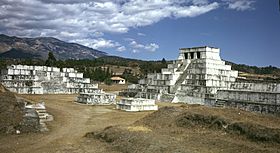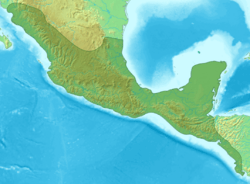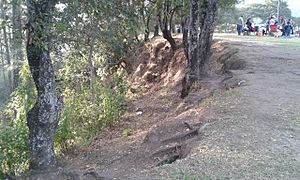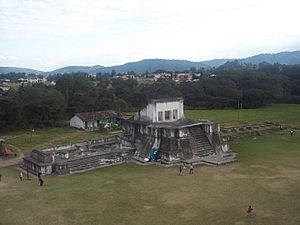Zaculeu facts for kids

Plaza 1 with Structure 6 at the left and Structure 1 at the right. The small platforms in the plaza are Structures 11 and 12.
|
|
| Alternative name | Saqulew |
|---|---|
| Location | Huehuetenango |
| Region | Huehuetenango Department, Guatemala |
| Coordinates | 15°20′1.66″N 91°29′33.88″W / 15.3337944°N 91.4927444°W |
| History | |
| Founded | Early Classic c.AD 250–600 |
| Abandoned | 1525 |
| Periods | Early Classic to Late Postclassic |
| Cultures | Maya civilization |
| Events | Conquered by: Kʼicheʼ Kingdom of Qʼumarkaj (Postclassic) Gonzalo de Alvarado y Contreras of Spain (1525) |
| Site notes | |
| Excavation dates | 1940s |
| Archaeologists | John M. Dimick |
| Architecture | |
| Architectural styles | Mesoamerican pyramids with talud-tablero style architecture and double stairways |
| Restored by United Fruit Company (Late 1940s) Responsible body: Ministerio de Cultura y Deportes | |
Zaculeu or Saqulew is an ancient Maya city in the western highlands of Guatemala. It's an archaeological site, meaning a place where old buildings and objects are found. The site is about 3.7 kilometers (2.3 miles) from the modern city of Huehuetenango.
People lived in Zaculeu as early as AD 250. It became the capital city of the Mam kingdom. Later, it was conquered by the Kʼicheʼ kingdom. Because of this, Zaculeu shows a mix of Mam and Kʼicheʼ building styles.
In 1525, Spanish conquistadors, led by Gonzalo de Alvarado y Contreras, attacked the city. The siege lasted for several months. The last ruler of Zaculeu, Kayb'il B'alam, surrendered because his people were starving.
The city has many temple-pyramids. These pyramids have a special style called talud-tablero and often have two stairways. The main buildings are grouped around large public plazas, which are like open squares. There is also a court for playing the ancient Mesoamerican ballgame. The city was once protected by strong walls.
The United Fruit Company helped restore the site in the late 1940s. Today, Zaculeu is open to tourists and has a small museum where you can learn more about its history.
Contents
What Does Zaculeu Mean and Where Is It?
The name Zaculeu means "white earth." This name comes from the Mam, Kʼicheʼ, and Q'anjob'al languages. Saq means "white" and ulew means "earth." In the Mam language, the site is also known as Chinabajul.
Zaculeu is located near the city of Huehuetenango in the Huehuetenango Department of Guatemala. It sits on a plateau, which is a flat area of high ground. This plateau is about 1,900 meters (6,200 feet) above sea level. The Sierra de los Cuchumatanes mountains are nearby.
The site is surrounded by fertile land, close to the Selegua and Viña rivers. Deep ravines on the south and east sides made it hard for enemies to attack. The only easy way into the site was a narrow land bridge to the north. This made Zaculeu a very good place for a city.
A Look at Zaculeu's Past
Zaculeu was first settled during the Early Classic Period (AD 250–600). Buildings from this time show the influence of Teotihuacán, a huge city in Mexico. The biggest buildings at Zaculeu were built during the Classic Period (AD 250–900).
More plazas and buildings were added in the Early Postclassic (AD 900–1200) and Late Postclassic (AD 1200–1525) periods. Zaculeu has been used as a special ceremonial site by the Mam Maya people continuously, even to this day.
During the Late Classic period, Zaculeu was again influenced by central Mexico. This influence was so strong that some historians think Mexican leaders might have lived in the city. They may have stayed there until the Kʼicheʼ people conquered the site.
How the Kʼicheʼ Conquered Zaculeu
The Kʼicheʼ Kingdom of Qʼumarkaj took over Zaculeu during the Postclassic period. For a long time, people thought this happened in the 1400s. But new studies using Radiocarbon dating suggest the Kʼicheʼ conquests might have happened earlier, possibly in the 1100s. The Kʼicheʼ ruled Zaculeu until the Spanish arrived in the early 1500s.
The Kʼicheʼ king Q'uq'umatz died fighting a group of northern Mam people. His son, K'iq'ab, continued the fight and finished conquering the region. K'iq'ab was the ruler when Zaculeu was conquered by the Kʼicheʼ. This might have been the second time the Kʼicheʼ took over the city.
When the Kʼicheʼ conquered a kingdom, they would put it under the control of one of their noble families. Based on the style of Structure 4, archaeologists think Zaculeu was likely controlled by the Nija'ib' family.
The Kʼicheʼ often built their new ruling centers on mountain tops to control the people in the valleys below. However, many of the original Mam people continued to live in Zaculeu.
The Kʼicheʼ rebuilt some older Classic period structures in their own style. A typical Kʼicheʼ temple faces west and has a steep front with two wings. This was probably the temple of Awilix, the goddess of the Nija'ib' Kʼicheʼ. A long palace building was to the north, and the ballcourt was to the southwest.
The Kʼicheʼ did not completely change the entire site. So, you can see both Mam and Kʼicheʼ building styles side-by-side. This shows how the local Mam leaders and the new Kʼicheʼ leaders blended together.
Archaeologists have found small metal ornaments at Zaculeu. One example is a butterfly made from tumbaga, which is a mix of gold and copper. These metal items show that Zaculeu was part of a larger trade network during the Postclassic period.
The Spanish Conquest of Zaculeu
Before the Spanish arrived, the Mam and Kʼicheʼ people sometimes fought. But when the Spanish conquistadors came, things changed. The Spanish leader Pedro de Alvarado wrote that the Mam king Kayb'il B'alam was welcomed with great honor in the Kʼicheʼ capital.
When the Spanish began their conquest, most Mam people lived in Xinabahul (now Huehuetenango). They moved to Zaculeu for safety because it was a fortified city. In 1525, Gonzalo de Alvarado y Contreras, Pedro de Alvarado's brother, attacked Zaculeu. He had 120 Spanish soldiers and about 2,000 Mexican and Kʼicheʼ allies.
The city was defended by King Kayb'il B'alam and about 5,000 people. After a siege that lasted several months, the Mam people ran out of food. King Kayb'il B'alam finally surrendered the city to the Spanish in October 1525. When the Spanish entered, they found 1,800 dead people. The Spanish made the people leave Zaculeu and built a new city, Huehuetenango, about 5 kilometers (3 miles) away.
Zaculeu in Modern Times
In 1840, American explorer John Lloyd Stephens and English architect Frederick Catherwood visited Zaculeu. At that time, it was a mess of overgrown ruins. Stephens wrote about the ruins a year later. Catherwood didn't draw the buildings because they were in such bad shape. They did dig up some ceramic pots, which Catherwood drew.
In 1931, Guatemala declared Zaculeu a National Monument. In 1946, the government allowed the United Fruit Company to dig and restore the site. John M. Dimick led this work. They even covered some buildings with white plaster, because they knew many were originally white. This is rare for ancient building restorations.
In 1970, the Guatemalan Ministry of Education officially declared Zaculeu a National Precolumbian Monument.
Exploring the Ancient City of Zaculeu
Zaculeu was likely built where it is because it was close to the Seleguá River, which provided water and a way to travel. Its hilltop location also made it easy to defend. The city has 43 structures. Most of the building happened quickly in the Early Classic period, with only small changes later. The smaller platforms in the plazas were added later and show influence from central Mexico. The only way into the site was a narrow land bridge to the north, which had a strong defensive structure.
The main part of the city, where ceremonies took place, covered about 1,400 square meters (15,000 sq ft). The buildings have the talud-tablero style and double stairways. Some buildings have round columns on their fronts, which is a feature seen in other parts of Mesoamerica.
Objects found at the site include items made from turquoise and precious metals. Metal items made from gold, silver, copper, and their mixes show that Zaculeu traded with other places in the Postclassic Period. These metal objects either came from or were influenced by Mexico and southern Central America.
The buildings at Zaculeu were grouped around small plazas. They were mostly made of masonry (stone and mortar) and covered with a thick layer of plaster. Some plaster pieces have flower and geometric designs, meaning the buildings were once brightly painted. The stones used were not shaped perfectly and were held together with adobe mortar.
Archaeologists have not found any corbel arches (a type of arch) or much stone sculpture. The buildings themselves have no stone carvings. Burials from the Early Classic period had many valuable items, but Late Classic burials had fewer offerings.
An Early Classic tomb was found under the main pyramid at Zaculeu. It was dug into the volcanic ash below the building. A wide stairway led down to the tomb from the main plaza. The inside of the tomb was painted red. The floor was covered with pieces of over 100 ceramic pots, which broke when the tomb's roof fell in.
Archaeologists also found 34 pyrite mirrors, like those found at Kaminaljuyu. A lot of jade was found, including beads and earplugs. Some jade beads were carved to look like human and parrot faces. The tomb held the bones of at least four people. The ceramic pots included decorated tripod vessels, colorful bowls, and a colorful cylindrical vase with hieroglyphs painted on it.
The center of the site has eight main plazas. Some of the buildings were restored by the United Fruit Company, mostly those around Plazas 1 and 2. Structures 1 and 2 are pyramid temples. Structures 4, 6, and 10 are palace structures. These are long buildings with rooms and benches inside, likely used as homes and for government work.
Main Plazas of Zaculeu
Plaza 1 is the main plaza. It is 54 by 38 meters (177 by 125 feet) and is surrounded by pyramid temples on all four sides.
Plaza 2 is a large plaza in the southeast part of the site, south of Plaza 1. It is bordered by Structure 4, Structure 1, the ballcourt, and Plaza 3.
Plaza 3 is a small plaza at the very south of the site, southwest of Plaza 2 and south of the ballcourt.
Plaza 4 is in the northwest part of the site. It is bordered by Structure 10, Structure 13, and the ballcourt. Plazas 5 and 6 are just to the west.
Plaza 5 is a small plaza west of Plaza 4 and northwest of the ballcourt. Structure 21 separates it from Plaza 6.
Plaza 6 is another small plaza west of Plaza 4. A building complex surrounds it on three sides, with Structure 21 on the southeast.
Plaza 7 is a small plaza at the far west of the site, west of Plazas 5 and 6.
Plaza 8 is an enclosed plaza southwest of the ballcourt. Structure 2, a pyramid, is on the northwest side, and Structure 3 is on the southeast side.
Important Buildings at Zaculeu
Structure 1 is a 39-foot (12-meter) high pyramid on the southeast side of Plaza 1. It has eight stepped levels and a small temple at the top. The temple has three doorways and is reached by a double stairway from the plaza. The pyramid was rebuilt seven times, with the visible parts dating to the Early Postclassic period. The oldest part was built in the Early Classic period.
Structure 2 is a pyramid on the northwest side of the sunken Plaza 8. Most of it has not been restored. Structure 3 is across the plaza.
Structure 3 is on the southeast side of Plaza 8, facing Structure 2. It is just south of the ballcourt.
Structure 4 is a unique building that combines a temple and a palace. It is on the southeast side of Plaza 2. The building has a central pyramid base with two attached long buildings. The pyramid has a temple on top with three rooms, and the last room is round. The temple has three steep stairways with railings. The main stairway goes straight from the plaza. The other two stairways are at right angles to the main one.
The front of the temple is in good condition, but the roof is gone. The two long buildings are different sizes and each has one long room on a low platform. The front of these rooms once had a row of columns, but only the bases remain. This temple-palace is in the Kʼicheʼ style and is thought to belong to the Nija'ib' Kʼicheʼ family. It looks very similar to the Temple of Awilix at Qʼumarkaj. A tomb was found in Structure 4 with a complete skeleton and offerings, including pottery, knives, jade beads, and gold fragments.
Structure 6 is a temple on the northeast side of Plaza 1. It has stepped levels and a temple at the top. A stairway from the plaza splits into two near the top. Only the lower parts of the walls and columns of the temple remain.
Structure 9 is a large mound on the northwest side of Plaza 1. The last stage of its construction was stopped by the Spanish Conquest. Terraces were missing on three sides, with only the lowest level built on the fourth side. Early Classic pottery was found hidden under Structure 9.
Structure 10 borders the northeast side of Plaza 4. It has not been restored, but some original stonework is visible. It is a very long building with three stairways from the plaza. Archaeologists found that it has many doorways leading into one long room.
Structures 11 and 12 are small platforms in the middle of Plaza 1. Both have been restored.
Structure 13 is on the southwest side of Plaza 1, separating it from Plaza 2. It has a double stairway from Plaza 1 that leads to the first level of the temple. From there, a wide single stairway goes to the top temple. Only the lower parts of the walls and columns of the temple remain. The oldest part was a low platform with a roof made of materials that would decay easily.
Structures 15 and 16 are low platforms in Plaza 2, directly across from the central temple of Structure 4.
Structure 17 is a pyramid base in Plaza 2, west of Structures 15 and 16. It supported two rooms accessed by a double stairway on the northwest side. The entrance to the outer room once had two columns, but only the lower parts of the walls and columns remain.
Structure 21 is a low platform in Plaza 5. It is partly restored and has a stairway on the northwest side.
The Ballcourt is made up of Structures 22 and 23. It was used for the ceremonial Mesoamerican ballgame. It is shaped like an "I" with sloping walls. The two structures forming the sides of the ballcourt once had buildings on top, but only the lower walls remain. The ballcourt is 48 meters (157 feet) long and runs from northwest to southeast.
Structure 37 is not connected to the main eight plazas. It stands about 50 meters (160 feet) northeast of Structure 4 and east of Structure 1. Archaeologists have studied it, but it has not been restored. Some original stonework and plaster are still visible.
See also
 In Spanish: Zaculeu para niños
In Spanish: Zaculeu para niños








